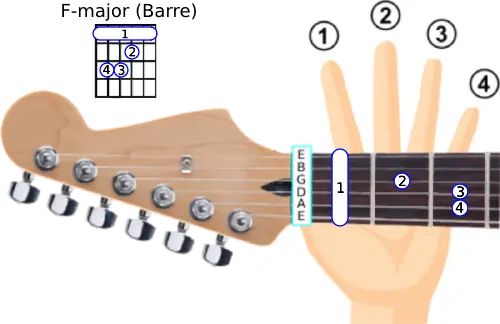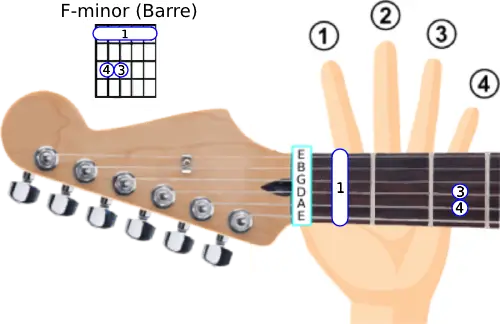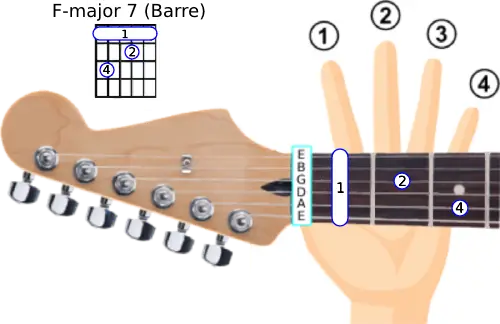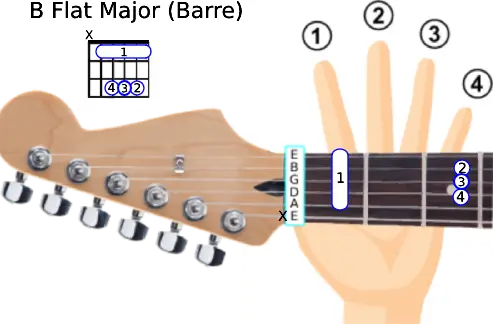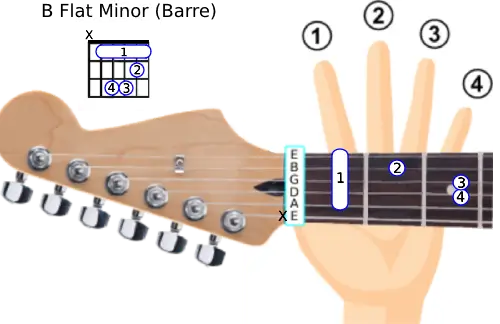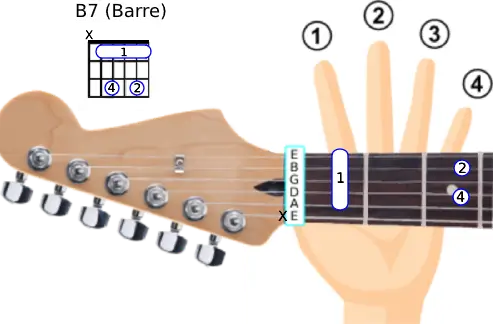Barre Chords.
Go To ChordsA barre chord, also known as a bar chord or barrered chord, is a type of guitar chord in which one or more fingers are used to press down on multiple strings across the guitar neck at the same fret. The term "barre" comes from the technique of using one finger to form a "bar" across the fretboard, effectively acting as a movable nut, while the other fingers are positioned to create the desired chord shape.
Common barre chord shapes include the E major barre chord and the A major barre chord, basically you use finger 1 (index finger) to barre across a fret and use your remaining fingers to play the E or A chord underneath. As you become more proficient with barre chords, you can move these shapes up and down the neck to play different chords. Barre chords are versatile and allow you to play a wide range of chords all over the fretboard.
To open the Voice Commands, just say, "Connie, Open the Command Hub."
Reading Chord Diagrams.
Chord diagrams offer easy to understand diagrams for learning finger placement and guitar chords. Here’s how to interpret chord charts to get playing:
- The six vertical lines represent your guitar strings, from lowest to highest: E, A, D, G, B, E.
- The horizontal lines represent each fret on your guitar.
- Decide on the chord you want to play as a barre chord. Common barre chords include major and minor chords, as well as seventh chords.
- Locate the root note of the chord on the low E (6th) string of the guitar. This will determine the position of the barre.
- Place your index finger across all the strings at a particular fret, acting as a bar. Ensure that your finger is pressing down firmly enough to make all the strings ring out clearly without buzzing.
- With your index finger barring the fret, use your other fingers to form the desired chord shape above the bar. The exact finger positions will depend on the chord you're playing.
- Once you have formed the chord shape and your index finger is barring the appropriate fret, strum all the strings from the low E (6th) string to the high E (1st) string. Make sure all the strings sound clean and clear. Adjust your finger pressure or finger position if necessary.
- When a long numbered area is covered a part of or has covered the whole of the fret, this means that fret, or section, should be barred with that finger. This is called a Barre chord.
Barre Chord Slide Show.
Take a moment to explore the Barre chord slideshow images below. These visuals all the Barre chords created by the open E and open A chords. Learning these will serve as your foundations into the world of music. For this lesson, we'll focus on creating Barre chords that are based on the E (major and Eminor) chords along with those based on the A major and A-minor. These chords can be played on any fret on your guitar, played correctly will produce all of the chords on the Guitar, the table below will tell you which chord you play. To make your learning experience easier, we've thoughtfully included a visual aid. The images selected for the slideshow, demonstrate the guitar illustration, accompanied by finger placement cues, allowing you to understand the chord transitions in real-time. In the upper left corner of each image, you'll find standard chord diagrams that provide a clear and straightforward approach to mastering these essentials. Ready to begin? Let's dive into it!
Barre Chord Fret Guide
| Fret Barred | Based On E Chord | Based On A Chord |
|---|---|---|
| 1st | F | B Flat |
| 2nd | F# | B |
| 3rd | G | C |
| 4th | G# | C# |
| 5th | A | D |
| 6th | B Flat | D# |
| 7th | B | E |
| 8th | C | F |
| 9th | C# | F# |
| 10th | D | G |
| 11th | D# | G# |
| 12th | E | A |
The Fingerboard is the primary component of most stringed instruments. It is a thin, long strip of wood adhered to the front of the neck of a string instrument. The strings run over the board, between the nut at the top of the guitar and the bridge at the bottom and over the sound hole on an Acoustic and the pick-ups on an Electric Guitar.
